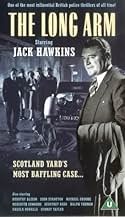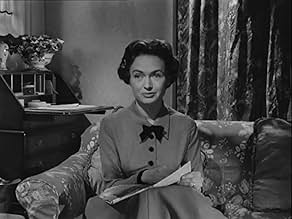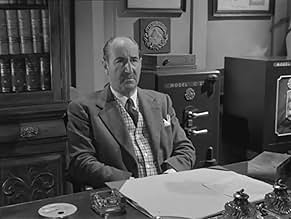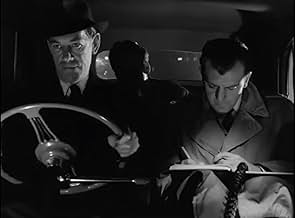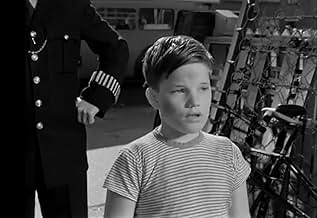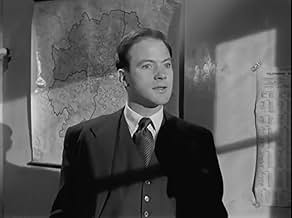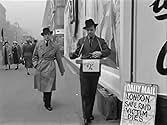NOTE IMDb
7,0/10
1,5 k
MA NOTE
Les détectives de Scotland Yard tentent de résoudre une série de cambriolages.Les détectives de Scotland Yard tentent de résoudre une série de cambriolages.Les détectives de Scotland Yard tentent de résoudre une série de cambriolages.
- Réalisation
- Scénario
- Casting principal
- Nomination aux 1 BAFTA Award
- 1 victoire et 1 nomination au total
Avis à la une
Agree with all previous comments. I first saw this film on TV 20 years ago on a wet Sunday afternoon and loved it. I recorded it on VHS the next time it was shown on telly, bought it when it came out on commercial VHS and have just placed an advance order on Amazon for the DVD version which is due out in February 2008.
It's a glimpse into a lost world - 1950s Britain - and all the more charming for it. A surprising amount of location shooting adds to the authenticity. Facsinating to see the Royal Festival Hall, for example, standing alone before the South Bank was developed. I even went on a pilgrimage to Long Acre to check out Stone & Company Ltd - it's still there and looks exactly the same (the building that is)! The detective work is logical, methodical and low-tech. Scraping some clothes fibres of a car radiator is about the height of the forensic work.
Some nice touches of humour too. Example: Jack Hawkins complaining that his Sergeant is running off to a payphone to call his girlfriend. "You haven't seen her," comes the reply, "she's worth three shillings for three minutes." That must have had them blushing in the 50s.
Things only slow a bit when we're dealing with the Hawkins domestic front but that's a small complaint and was no doubt intended to inject a little social realism.
Find yourself a quiet afternoon, make yourself a cup of tea, crack open the custard creams and enjoy.
It's a glimpse into a lost world - 1950s Britain - and all the more charming for it. A surprising amount of location shooting adds to the authenticity. Facsinating to see the Royal Festival Hall, for example, standing alone before the South Bank was developed. I even went on a pilgrimage to Long Acre to check out Stone & Company Ltd - it's still there and looks exactly the same (the building that is)! The detective work is logical, methodical and low-tech. Scraping some clothes fibres of a car radiator is about the height of the forensic work.
Some nice touches of humour too. Example: Jack Hawkins complaining that his Sergeant is running off to a payphone to call his girlfriend. "You haven't seen her," comes the reply, "she's worth three shillings for three minutes." That must have had them blushing in the 50s.
Things only slow a bit when we're dealing with the Hawkins domestic front but that's a small complaint and was no doubt intended to inject a little social realism.
Find yourself a quiet afternoon, make yourself a cup of tea, crack open the custard creams and enjoy.
8cb49
I echo Mike Wilson's views on this film, it is the classic British crime drama. Jack Hawkins is superb (and I feel that John Gregson's TV portrayal of Gideon was based on this). It even has little touches of humour which succeed in making the movie real. I would also agree with Mike that the later Gideon of Scotland Yard is poor in comparison, if Jack Hawkins had played the character in the same manner as he played Supt. Halliday, it could have been perfect. The movie has just been re-issued in the UK (Feb. 2003) on VHS.
In this cracking black and white police drama, Ealing comes up trumps yet again. Made in 1956, with good locations in and around London, the story concerns Jack Hawkins, as Superintendent Halliday, who has to track down, a very clever cat burglar, who is an expert in disguises.
What makes this film so interesting, is that Hawkins, trying to reproduce the character, made a similar film, 2 years later, called 'Gideon of Scotland Yard', which was shot in colour by the great John Ford. Where 'Long Arm' succeeded in every way, 'Gideon' was a shambles. It just proves that the one of greatest directors in Hollywood history, and a good cast , are hamstrung, without a reasonable script. 'Long Arm' holds you in suspense right up the final scene, even when you know, that the cinema code of the day, will not allow the villain to escape. A good supporting cast from a large range of well known British actors, makes this film a must to see. 8 out of 10.
What makes this film so interesting, is that Hawkins, trying to reproduce the character, made a similar film, 2 years later, called 'Gideon of Scotland Yard', which was shot in colour by the great John Ford. Where 'Long Arm' succeeded in every way, 'Gideon' was a shambles. It just proves that the one of greatest directors in Hollywood history, and a good cast , are hamstrung, without a reasonable script. 'Long Arm' holds you in suspense right up the final scene, even when you know, that the cinema code of the day, will not allow the villain to escape. A good supporting cast from a large range of well known British actors, makes this film a must to see. 8 out of 10.
This wonderful film shot in London and Wales during late 1955 is a must for all lovers of 1950's British cinema and this late Ealing Studios masterpiece is as good as anything ever to leave the cutting room of that great British film institution. As simply a film the plot of an unsolvable robbery is very cleverly constructed and little by little the expert veteran detective (Hawkins) and his new sergeant nibble away at the clues, it may seem rather familiar but this is the template on which the likes of the TV Gideon of Scotland yard was built. Hawkins always excellent is brilliant throughout totally convincing as the career copper who loves his job. Back in the nineteen fifties the coppers always got their bad guy and no villain was beyond the law as the title infers, cynicism and shades of Gray would have to wait another decade or so more. Fans of the era such as my self sees a treasure trove of fifties stereotypes but stay at home house wives were the normal back then as was chain smoking drinking on the job if only a small beer and the odd whiskey for bigger problems, everyone wore an overcoat and a hat while London was mostly Gray dull damp smog-ed and still bombed out while car owner ship was still mostly for the better off. Please note the car park right outside the doors of the Royal Festival hall, then only a few years old, boy was parking handy back then. My old Dinky toy cars were in every day use Ford Pilot, Wolseley 4/44 police cars, a Jaguar mark on. Oh! Oh! the nostalgia and all in glorious black and white. Enjoy!
This is a superb police detection drama, with Jack Hawkins as the warm-hearted focus of a rather complex crime saga. The best supporting performance is by Ursula Howells, who brilliantly conveys neurotic menace and desperation in just a few scenes. The young Ian Bannen is killed off very quickly, but already in this early appearance we can see his superior qualities working on screen. This 1956 British film is clearly an attempt to emulate the 1940s and 1950s Hollywood films such as 'The House on 92nd Street', directed by Henry Hathaway, since it also portrays stolid and patient police work, shown in loving detail. There are no 'noir' elements to this drama, and the crime is just crime, with no psychology or angst. The plot has some intriguing novelties. In the first safe robbery at the beginning of the film, the thief remains at the scene of the crime and pretends to be a night watchman, lets the police in, shows sympathy and bewilderment, and then makes his escape after they have gone. The whole case really is a brain-teaser, and well worth viewing by any chess player or detective enthusiast. It is a superior British film of its genre.
Le saviez-vous
- AnecdotesThe last film made at Ealing Studios, London.
- GaffesWhen a kid try to sell a new car's lamp, the policeman took him back to the junk yard and the lamp is still in car.
Sorry, not a goof. The two lamps on the front of the damaged car are the headlights, or lamps if you prefer. The boy had taken the fog lamp off the car. The fog lamp was a third lamp as may be seen at 34 mins when the collision occurs. The fog lamp is clearly seen on the nearside just above the bumper. When the car is on on the dump, the fog lamp is not there.
- Citations
[during the final chase, Halliday leaps onto the bonnet of the getaway car and stops it by smashing its windscreen with his truncheon; as it lurches to a halt, he falls off the bonnet onto the ground. Ward helps him up]
Detective-Sergeant Ward: Are you all right, sir?
Detective-Superintendent Tom Halliday: I'll live, I think.
Detective-Sergeant Ward: Nothing broken?
[Halliday pauses and looks mortified]
Detective-Superintendent Tom Halliday: Yes - a promise I made to let *other* people take the risks!
- Crédits fousSPOILER: In the end credits Ursula Howells is credited twice: first as her fake character Mrs. Elliot, and then at the end as Mrs. Gilson, the wife of Gilson the criminal.
- ConnexionsReferenced in The Kiss (1958)
Meilleurs choix
Connectez-vous pour évaluer et suivre la liste de favoris afin de recevoir des recommandations personnalisées
- How long is The Third Key?Alimenté par Alexa
Détails
- Date de sortie
- Pays d’origine
- Langue
- Aussi connu sous le nom de
- The Third Key
- Lieux de tournage
- Pen-Y-Gwryd, Gwynedd, Pays de Galles, Royaume-Uni(Mr Thomas's garage where the newspaper was delivered)
- Société de production
- Voir plus de crédits d'entreprise sur IMDbPro
- Durée
- 1h 36min(96 min)
- Couleur
- Rapport de forme
- 1.85 : 1
Contribuer à cette page
Suggérer une modification ou ajouter du contenu manquant

